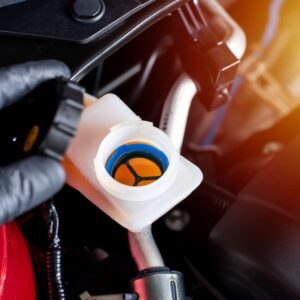Absolutely. A vehicle’s braking system relies heavily on a brake fluid’s ability to remain in a liquid state under pressure and heat.
If the brake fluid boils due to the heat generated by the brake pads and calipers, then your vehicle might have reduced braking performance. Let’s discuss what happens when brake fluid boils, the different brake fluid types, and why picking the correct brake fluid type is important for optimal brake performance.

What Happens When Brake Fluid Starts to Boil?
When you apply the brakes, heat from the brake pads will transfer to the brake caliper and then the brake fluid. High-temperature brake fluid can boil and vaporize, producing gases inside the brake system.
Gases in the braking system will result in a spongy brake pedal because of compressed air bubbles that make it harder to push the brake caliper. This occurrence is called fluid fade, and it can lead to complete brake failure.
What Are Brake Fluid Boiling Points?
Each type of DOT brake fluid can withstand specific temperatures. These standards are set by the Society of Automotive Engineers and the Department of Transportation (DOT), hence the name of the fluid.
Each DOT fluid type has varying characteristics and boiling points. As a result, each DOT fluid type is meant for a specific use case.
For example, DOT 3 brake fluid is suitable for everyday vehicles. When comparing DOT 3 vs 4 brake fluid, DOT 4 is more suitable for high-performance applications, such as track use or heavy trucking. Generally speaking, higher boiling points mean the brake fluid is better for use in high-performance vehicles.
That said, remember that not all vehicles are compatible with other brake fluid types.
| Brake Fluid | Dry Boiling Point | Wet Boiling Point (Used) | Chemical Composition |
| DOT 3 | 401 °F | 284 °F | Glycol Ether |
| DOT 4 | 446 °F | 311 °F | Glycol Ether/Borate Ester |
| DOT 5 | 500 °F | 356 °F | Silicone |
| DOT 5.1 | 518 °F | 374 °F | Borate Ester/Glycol Ether |
What Are Dry and Wet Boiling Points?
If brake fluid is fresh from the container, it will boil when it reaches its dry boiling point. Meanwhile, the brake fluid becomes wet when it absorbs 3.7% water by volume.
As the vehicle is driven, brake parts like the calipers can allow water to reach the fluid. When the brake fluid has absorbed some water, it will have a lower boiling point, which can increase the likelihood of brake fluid fade and compromise your safety.
The brake fluid inside every vehicle absorbs moisture at different rates. That said, it’s generally agreed upon that a vehicle’s brake fluid absorbs enough water to be at a wet state after around two years. This is why you must replace your vehicle’s brake fluid based on your owner’s manual.
Where Does the Water Come From?
Brake hoses, seals, joints, and seams typically have microscopic pores or holes. Glycol-based brake fluid is hygroscopic, which means it naturally attracts water molecules from the surrounding air. Despite the extremely minimal exposure to air, the brake fluid will become wet after a certain period. This process is faster if you live in a humid or moist climate.
Other Brake Fluid Variables to Consider
Despite the benefits of other DOT fluids, you shouldn’t deviate from your manufacturer’s recommended brake fluid type. The brake fluid you put in your vehicle must be compatible with braking system components because some brake fluids might not agree with the brake seals and stability control systems present in certain brake systems. Using a different brake fluid type can lead to corrosion and accelerated wear.
Vehicle braking systems are also expected to be filled with a brake fluid with a specific viscosity and compressibility. Using a different brake fluid can result in different viscosity and compressibility, potentially affecting brake performance and reliability.
Any information provided on this Website is for informational purposes only and is not intended to replace consultation with a professional mechanic. The accuracy and timeliness of the information may change from the time of publication.































